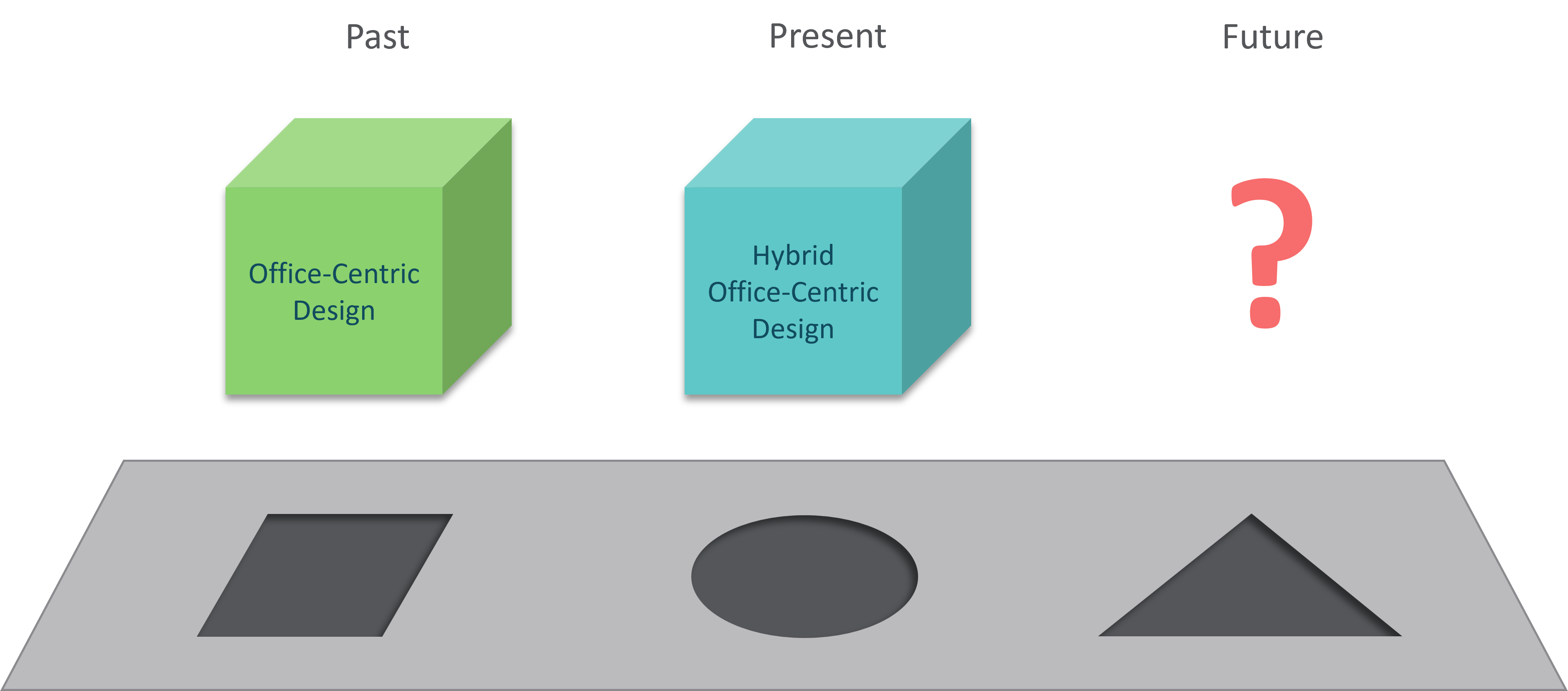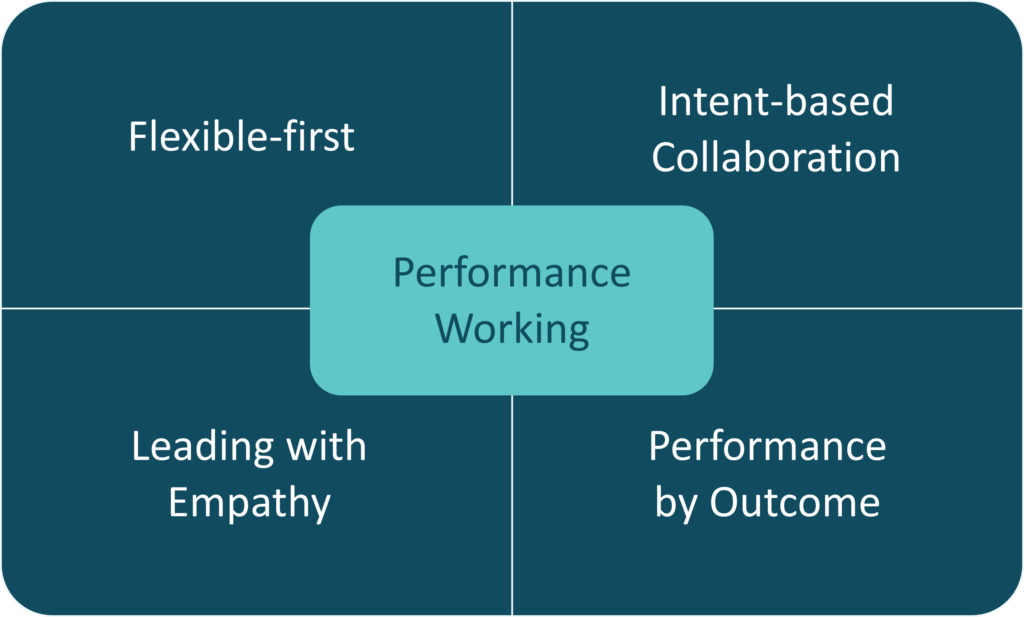When it comes to hybrid working, many of our clients are still struggling to find a balance between the needs of their organisation and the needs of their employees. They feel that some of the key characteristics of the working environment that existed before the pandemic such as a consistent employee experience, the ability to monitor what employees were actually doing, and in-person collaboration are significantly diminished, and this is negatively impacting productivity and innovation.
To counter this, we see many organisations try to re-create office-centric design in a virtual setting to get back what they feel they have lost. The challenge with this is that the world has moved on. Trying to force an old structure on the new world we now live in doesn’t work and causes stress for both managers and employees. It is, if you like, trying to force a square peg into a round hole.

Introducing Performance Working
When thinking about how to make the best of the new world of working we now live in, it is worth taking a step back and thinking about the kind of culture that is desired; that will help create the organisational and customer outcomes that benefit all stakeholders. We have been working with clients on building high-performing cultures for more than 25 years. We call this a performance culture: one that enables breakthrough outcomes and supports and enables everyone, from the individual and team level, to the whole organisation. We believe that defining what good looks like clearly (the behaviours that lead to a performance culture) and embedding this definition throughout the entire employee lifecycle creates ‘behaviour at scale,’ which is the foundation for a performance culture.
Therefore, a key element of performance culture post-pandemic is dealing with the new reality of hybrid working. Our view is that what is required is a revolution, rather than the evolution of working practices, to deal with the new reality that will enable individuals and teams to thrive, reducing digital overload and burnout. Performance Working is based on four key aspects:

Flexible-first means that flexible working is the default, not the exception. This gives the power over to the employee of where, when and how to work, within a set of team guardrails. It’s key to recognise that individuals work within teams, and any team needs an operating rhythm and high degrees of collaboration. Each team is different, so the individuals within the team must demonstrate connected leadership to work together in agreeing individual flexibility that still works within the context of the team to achieve their outcomes. Leaders need to work with their teams on the flexible working they need, demonstrating empathy-based leadership (the fourth element, below).
Intent-based collaboration means thinking about the four quadrants of the new working environment across their two dimensions of a) working remotely, or co-located, and b) working synchronously or asynchronously. Instead of replacing the previous office-based serendipity of unplanned meetings and connections with just more virtual meetings, teams are intentional about which form of collaboration is right to achieve the desired outcome. For example, working asynchronously but physically together in an office can be hugely beneficial for junior employees who can observe and interact with others, including holding mentoring or coaching sessions. Just like in the flexibility-first element of Performance Working, teams are left to determine the right kind of collaboration for them, and leaders support them in making this happen.
Performance by Outcome means moving away from measurement by management and instead, leaders focusing on how to enable and support their teams to achieve outcomes. For example, many technology teams use DORA metrics to drive how they work. These metrics help in improving efficiency, quality and productivity, but they don’t tell you if you are delivering the outcomes needed by customers or to help the business win. Instead, we must be sure we are continually delivering outcomes and use a combination of leading and lag indicators to get a more complete picture. Teams are better able to achieve or enable these outcomes if they have autonomy over how they work, as described in the Flexible-first and Intent-based collaboration elements of Performance Working.
Leading with Empathy means equipping leaders with the skill, mindset and capacity to focus on their people. Leading with empathy as opposed to a task focus, becoming comfortable with difficult or vulnerable conversations, being able to give constructive feedback, and focusing on providing growth and development opportunities that help each team member grow.
The key to making Performance Working successful is the concept of Accountable Autonomy. Just like how DevOps moves decisions about how teams work to be determined by the teams themselves, Performance Working needs teams to determine what is best for them, both in terms of flexibility and collaboration. This is the Autonomy aspect, facilitated by managers leading with empathy. However, they need to be assessed against the value they provide and the business outcomes they enable and support. This is the Accountable aspect.
Additionally, Performance Working is supported by:
- Performance Playbooks that have tools and techniques which will help the teams perform,
- Performance Coaches that go from team to team to support performance working and share best practice
- Performance Working training for managers to learn how to lead with empathy
- Diagnostics to help teams understand how to continually improve,
- “Outcome-spectives” that review how the team work collectively to achieve their outcomes, learn and then adapt as necessary.
Connected Leadership is critical to enable Performance Working
Performance Working is aligning the needs of the organisation and team to the needs of the individual. This is only possible if leaders connect with their teams and employees, along with other leaders, to learn what works and what’s needed. All four elements of Performance Working require individuals to speak up within a team environment about what they need and how this works within the structure and operating rhythm of the team. Leaders need to listen, be willing to be vulnerable in not having all the answers, lead with empathy and empower their teams to work in the best ways for them to deliver measurable outcomes. Without Connected Leadership, we can easily fall back into current hybrid working habits, which will not deliver the desired outcomes nor engage, motivate and retain talent.



